
As the 1950’s progressed into its early years, the circus continued to maintain a position of prominence in American pop culture and in cinema, both in the animated and live-action worlds. Most notably during this time, one of the nation’s most prestigious directors, no less than Cecil B. DeMille, would take home a gleaming gold statuette with Best Picture honors for 1952’s “The Greatest Show on Earth”, a circus extravaganza starring Betty Hutton. This week’s animated offerings range from formulaic to spectacle, including a classic Bugs Bunny, myopic Magoo madness, and a double-dose of Tom and Jerry climaxing in a delightful exercise in “mind games”.
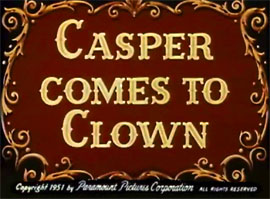 Casper Comes to Clown (Paramount/Famous, Casper, 8/10/51 – I. Sparber, dir.) – Typical formula Casper fare. Casper is laughed out of the haunted house for wanting to make friends. In his travels, he encounters a bear cub being pursued by a swarm of angry bees (shaped into the flying formation of a giant pair of scissors nipping at the cub’s tail). The sight of Casper re-forms the swarm into the letters, “A ghost”, and results in their hasty exit. Casper names the cub Brownie (not exactly original, as Official Films home movies were already using the name for reissues of Van Beuren Cubby Bear cartoons). While tossing down an apple from a tree to the cub, Casper observes the bear ad-libbing the trick of balancing the apple on his nose before swallowing it. Casper retrieves a tin can full of water out of a stream and a long stick, and tries Brownie out at repeating the trick with the new props. Brownie does pretty good for a few moments in balancing the can atop the stick, but eventually gets doused in water. Casper is nevertheless convinced that Brownie has talent, and thinks he can train Brownie to be a trick bear with only a little more practice. Soon, Casper has Brownie following him, balanced atop a rolling hoop, juggling balls, and balancing the stick and can on his nose, all at the same time. Casper sings an original song, “Brownie Is a Juggling Bear”. Casper follows one path at a fork in the road, but Brownie, his nose high to balance the can, does not see Casper’s turn, and continues straight ahead, across a highway. Brownie is spotted by a circus truck (for the Famous Circus – a direct plug of both Paramount’s and the animation studio’s long-standing surname), and the Ringmaster leaps out, stating, “What an act for the circus!’ Brownie is quickly picked up by the Ringmaster and deposited in the truck. Casper returns to the scene, discovering only the hoop and stick left behind.
Casper Comes to Clown (Paramount/Famous, Casper, 8/10/51 – I. Sparber, dir.) – Typical formula Casper fare. Casper is laughed out of the haunted house for wanting to make friends. In his travels, he encounters a bear cub being pursued by a swarm of angry bees (shaped into the flying formation of a giant pair of scissors nipping at the cub’s tail). The sight of Casper re-forms the swarm into the letters, “A ghost”, and results in their hasty exit. Casper names the cub Brownie (not exactly original, as Official Films home movies were already using the name for reissues of Van Beuren Cubby Bear cartoons). While tossing down an apple from a tree to the cub, Casper observes the bear ad-libbing the trick of balancing the apple on his nose before swallowing it. Casper retrieves a tin can full of water out of a stream and a long stick, and tries Brownie out at repeating the trick with the new props. Brownie does pretty good for a few moments in balancing the can atop the stick, but eventually gets doused in water. Casper is nevertheless convinced that Brownie has talent, and thinks he can train Brownie to be a trick bear with only a little more practice. Soon, Casper has Brownie following him, balanced atop a rolling hoop, juggling balls, and balancing the stick and can on his nose, all at the same time. Casper sings an original song, “Brownie Is a Juggling Bear”. Casper follows one path at a fork in the road, but Brownie, his nose high to balance the can, does not see Casper’s turn, and continues straight ahead, across a highway. Brownie is spotted by a circus truck (for the Famous Circus – a direct plug of both Paramount’s and the animation studio’s long-standing surname), and the Ringmaster leaps out, stating, “What an act for the circus!’ Brownie is quickly picked up by the Ringmaster and deposited in the truck. Casper returns to the scene, discovering only the hoop and stick left behind.
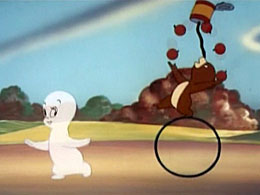 Casper wanders in search of his lost friend, and encounters a billboard advertising Brownie’s act in the next town. He flies to the circus grounds, and peers in at one of the tent entrances without being noticed. Brownie’s act is in progress, moving his performance onto a high wire above the arena. All eyes in the tent are upon him, including those of a small monkey, leaping with excitement atop the cage of a massive gorilla. The monkey obtains a small ball and begins tossing it around in imitation of the juggling. Then, the monkey spies a wooden peg inserted in the top of the cage door below him to secure it. Playfully, the monkey removes the peg, attempting to balance it atop his own nose. The cage door opens, and the gorilla is freed. The Ringmaster finds himself in the ape’s shadow, and makes no attempt to take a stand, but instead quickly retreats. The crowd evacuates the tent rapidly, and all that are left are Casper, the Ringmaster in hiding, and Brownie high above, still oblivious to the goings-on with his head pointed high in the air. The gorilla uproots the two poles to which the high-wire is tied, shifting them up and down to tilt the wire in attempt to unbalance Brownie. Brownie continues to maintain his balance, so the gorilla pulls the two poles apart to extend the wire to full tightness, popping Brownie into the air. Brownie lands on one of the ape’s giant paws, and the ape rears back with his other paw to give Brownie a smashing blow. Casper as usual flies in to defend, causing the ape’s eyes to pop, and a quick retreat back to his cage. The ape reaches the cage with such speed, he smacks into the cage’s rear wall, breaking himself up into the three “Hear no evil, see no evil” monkeys. The film ends with Casper added into the act, now juggling himself while balanced on a hoop and stick atop Brownie’s nose.
Casper wanders in search of his lost friend, and encounters a billboard advertising Brownie’s act in the next town. He flies to the circus grounds, and peers in at one of the tent entrances without being noticed. Brownie’s act is in progress, moving his performance onto a high wire above the arena. All eyes in the tent are upon him, including those of a small monkey, leaping with excitement atop the cage of a massive gorilla. The monkey obtains a small ball and begins tossing it around in imitation of the juggling. Then, the monkey spies a wooden peg inserted in the top of the cage door below him to secure it. Playfully, the monkey removes the peg, attempting to balance it atop his own nose. The cage door opens, and the gorilla is freed. The Ringmaster finds himself in the ape’s shadow, and makes no attempt to take a stand, but instead quickly retreats. The crowd evacuates the tent rapidly, and all that are left are Casper, the Ringmaster in hiding, and Brownie high above, still oblivious to the goings-on with his head pointed high in the air. The gorilla uproots the two poles to which the high-wire is tied, shifting them up and down to tilt the wire in attempt to unbalance Brownie. Brownie continues to maintain his balance, so the gorilla pulls the two poles apart to extend the wire to full tightness, popping Brownie into the air. Brownie lands on one of the ape’s giant paws, and the ape rears back with his other paw to give Brownie a smashing blow. Casper as usual flies in to defend, causing the ape’s eyes to pop, and a quick retreat back to his cage. The ape reaches the cage with such speed, he smacks into the cage’s rear wall, breaking himself up into the three “Hear no evil, see no evil” monkeys. The film ends with Casper added into the act, now juggling himself while balanced on a hoop and stick atop Brownie’s nose.
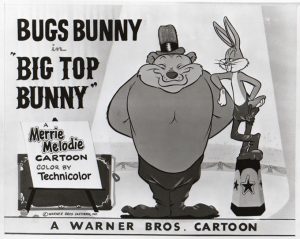 Big Top Bunny (Warner, Bugs Bunny, 12/12/51 – Robert McKimson, dir.) – Colonel Korny’s Circus doesn’t think it needs any more animal acts – not with its star attraction of Bruno, the Slobokian acrobatic bear – a muscular lug with a Russian-like accent and an irrepressible ego. But when a phone call announces the availability of the world’s only acrobatic rabbit, the Colonel eagerly responds to send the new star over, planning to partner him with Bruno. “Nobody shares the spotlight with Bruno the Magnificent”, snarls the bear from his cage, “…especially a stinkink little rabbit!”
Big Top Bunny (Warner, Bugs Bunny, 12/12/51 – Robert McKimson, dir.) – Colonel Korny’s Circus doesn’t think it needs any more animal acts – not with its star attraction of Bruno, the Slobokian acrobatic bear – a muscular lug with a Russian-like accent and an irrepressible ego. But when a phone call announces the availability of the world’s only acrobatic rabbit, the Colonel eagerly responds to send the new star over, planning to partner him with Bruno. “Nobody shares the spotlight with Bruno the Magnificent”, snarls the bear from his cage, “…especially a stinkink little rabbit!”
The new act debuts that evening. Emerging from a rabbit hole set into a circus platform rises Bugs, propelled by internal elevator, to the cheers of the crowd. Bruno receives second introduction as “partner”, but hogs the spotlight by standing directly in Bugs’s way, then taking a deep bow, swinging backwards one arm to knock Bugs clear out of the ring. Bugs takes in the situation with his usual cool, returning to lean on the bowing Bruno’s shoulder, and ask his trademark “What’s up, doc?” Bruno covers as if it was an accident, then mounts a ladder to a diving platform as the act begins. “En guard…er, are you ready, little partner?” calls Bruno from above. Bugs waits on the opposite end of a teeter-totter below, standing under a series of bulls-eye hoops fastened to a tall tent pole. Bruno jumps on the other end of the teeter-totter, launching Bugs skyward. Through one hoop, then two, then CLANG!! The third hoop is blocked from above – by an anvil placed atop it. “Now who you suppose put that anvil way up there?”, inquires Bruno, as a halo magically appears over his head to augment his feigned lack of knowledge. Bugs, with a large lump on his head, grumbles to us in the audience, “Innocent as a newborn baby – baby rat, that is.”
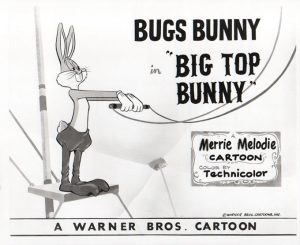 The act moves to the trapeze. Bruno, at one end of the tent, is assigned catching duties. He calls for Bugs to swing from his end of the tent, assuring him that “Nothing could happen to you.” Bugs, still suspecting Bruno is up to no good, asides to the audience, “Don’t you believe it!” Bugs launches himself, sailing through the air, and calls, “Catch me, Bruno”. Bruno pulls back his arms into a gesture as if cupping one hand around his ear for a close listen, calmly remarking, “Did somebody call my name?” Bugs falls, but takes the mishap in anticipated stride. He produces from a pocket of his acrobatic suit an old pocket watch, opens its back, and extracts two mainsprings (an odd stretch of mechanical engineering – but what else can you expect in a cartoon). Hooking a spring to each of his feet, he easily bounces off the arena floor, back up into the heights of the tent. By this time, he has produced from nowhere a phone, which he hands to Bruno, saying the “caller” was someone who wanted him on the phone. Bugs safely disappears out of the frame, as Bruno answers the call, pausing motionless in mid-air as his trapeze falls away. “Hello, Bruno”, says Bugs’s voice on the line. “What’cha doin’ in the air all by yourself?”, he asks. Bruno commits the cardinal sin of a character defying gravity, and looks down. He plummets into the circus band below, lands inside and then is quickly blown out of the bell of the tuba, and plops through the head of a kettle drum, with the drummer completing a “shave-and-a-haircut” drum beat upon the bear’s chest and head.
The act moves to the trapeze. Bruno, at one end of the tent, is assigned catching duties. He calls for Bugs to swing from his end of the tent, assuring him that “Nothing could happen to you.” Bugs, still suspecting Bruno is up to no good, asides to the audience, “Don’t you believe it!” Bugs launches himself, sailing through the air, and calls, “Catch me, Bruno”. Bruno pulls back his arms into a gesture as if cupping one hand around his ear for a close listen, calmly remarking, “Did somebody call my name?” Bugs falls, but takes the mishap in anticipated stride. He produces from a pocket of his acrobatic suit an old pocket watch, opens its back, and extracts two mainsprings (an odd stretch of mechanical engineering – but what else can you expect in a cartoon). Hooking a spring to each of his feet, he easily bounces off the arena floor, back up into the heights of the tent. By this time, he has produced from nowhere a phone, which he hands to Bruno, saying the “caller” was someone who wanted him on the phone. Bugs safely disappears out of the frame, as Bruno answers the call, pausing motionless in mid-air as his trapeze falls away. “Hello, Bruno”, says Bugs’s voice on the line. “What’cha doin’ in the air all by yourself?”, he asks. Bruno commits the cardinal sin of a character defying gravity, and looks down. He plummets into the circus band below, lands inside and then is quickly blown out of the bell of the tuba, and plops through the head of a kettle drum, with the drummer completing a “shave-and-a-haircut” drum beat upon the bear’s chest and head.
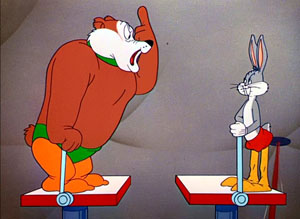 Let’s try the trapeze bit once more. Bugs swings out. This time, Bruno says, “Okay, partner, grab” – but instead of his sturdy hands, passes Bugs the detached handlebars of a bicycle, rigged with two brown gloves instead of handles to fool Bugs into clasping onto the bait. As Bugs finds himself alone in the air again, he reverts to pedaling with his feet like mad, though there are no pedals nor bike. The “invisible bike” gag works, and Bugs is miraculously propelled and saved, reaching Bruno’s platform and “dismounting”. Totally perplexed, the bear, full more of bravado than of brain, states, “I don’t know how you do dis = but if you could do it, Bruno could do it better!” Bruno takes the handlebars, starts pedaling – and gets two feet off the platform before diving again. In a clever direction move that is nearly a steal of technique from Friz Freleng, we do not see the results of the fall, but hear a repeat of the same sound effects from the previous sequence, of Bruno again getting mixed up with the tuba and kettle drum below. Bugs slides down a rope, and declares to Bruno that he is dissolving the partnership. “You’ve ruined the act. You’re too clumsy”, he declares. Then Bugs advances to a position in the center of the arena, where two square platforms are positioned side by side, each mounted to a massive hydraulic lift and including a control handle to operate the device. Bruno inquires, “Hey, what ‘chu think you gon’ do?” “I’m gonna dive 200 feet off this platform into a tank of water”, replies Bugs. Tugging at the control handle, Bugs rises to the desired height. Bruno mounts the second platform, and meets him above the arena. “Nobody could outdo Bruno the Magnificent.
Let’s try the trapeze bit once more. Bugs swings out. This time, Bruno says, “Okay, partner, grab” – but instead of his sturdy hands, passes Bugs the detached handlebars of a bicycle, rigged with two brown gloves instead of handles to fool Bugs into clasping onto the bait. As Bugs finds himself alone in the air again, he reverts to pedaling with his feet like mad, though there are no pedals nor bike. The “invisible bike” gag works, and Bugs is miraculously propelled and saved, reaching Bruno’s platform and “dismounting”. Totally perplexed, the bear, full more of bravado than of brain, states, “I don’t know how you do dis = but if you could do it, Bruno could do it better!” Bruno takes the handlebars, starts pedaling – and gets two feet off the platform before diving again. In a clever direction move that is nearly a steal of technique from Friz Freleng, we do not see the results of the fall, but hear a repeat of the same sound effects from the previous sequence, of Bruno again getting mixed up with the tuba and kettle drum below. Bugs slides down a rope, and declares to Bruno that he is dissolving the partnership. “You’ve ruined the act. You’re too clumsy”, he declares. Then Bugs advances to a position in the center of the arena, where two square platforms are positioned side by side, each mounted to a massive hydraulic lift and including a control handle to operate the device. Bruno inquires, “Hey, what ‘chu think you gon’ do?” “I’m gonna dive 200 feet off this platform into a tank of water”, replies Bugs. Tugging at the control handle, Bugs rises to the desired height. Bruno mounts the second platform, and meets him above the arena. “Nobody could outdo Bruno the Magnificent.
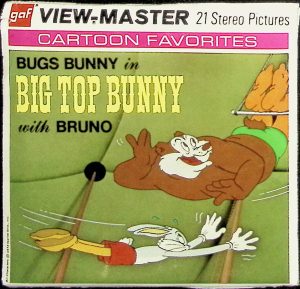 I dive 300 feet into bucket of water.” Bruno jacks his platform another 100 feet, to the top of the tent, then Bugs joins him. “I’ll dive 500 feet into a damp sponge.” Bugs jacks his platform clear through the canvas roof, where he is again met by Bruno. “And I’ll dive 1,000 feet into block of cement – – on my head, yet!” They both meet in the stratosphere, where Bugs buys that Bruno has proposed a good stunt – but the star goes first. Bugs feigns readiness to dive, until Bruno seizes Bugs’s neck in one huge fist. “I GO FIRST!!!”, he demands. Bugs is more than happy to let Bruno have his own way. How any of the stagehands could have heard this conversation from below remains a question – but someone has already positioned below Bruno a huge block of solid cement, into which the bear smashes with a dull thud, his whole upper torso temporarily flattened like a pancake. As Bruno falls away from the block, groggily popping back to semi-normal shape, Bugs, somehow already on the ground, hands Bruno a gift basket, throws flower leis around Bruno’s neck, and escorts him to what appears to be a ship’s gangplank, while wishing him “Bon voya-gee. Have a nice trip,” “But I’m not going on any trip”, mumbles Bruno. “Oh yes, you are”, replies Bugs, wielding a pair of scissors to cut a nearby rope. Instead of a gangplank, Bruno is standing upon the teeter-totter again, and the cut rope lets loose a 1,000 pound weight on the board’s other end. Bruno runs the gauntlet, rebounding off a trampoline, a fat lady’s stomach, an acrobat’s feet, getting whacked by whirling trapeze performer, landing on a bicycle and riding down a loop-de-loop ramp, then falling neatly into a cannon, which Bugs fires, launching Bruno out through the roof of the tent and out of show business. “Well, that’s one way to wind this up with a bang”, declares Bugs for the curtain line.
I dive 300 feet into bucket of water.” Bruno jacks his platform another 100 feet, to the top of the tent, then Bugs joins him. “I’ll dive 500 feet into a damp sponge.” Bugs jacks his platform clear through the canvas roof, where he is again met by Bruno. “And I’ll dive 1,000 feet into block of cement – – on my head, yet!” They both meet in the stratosphere, where Bugs buys that Bruno has proposed a good stunt – but the star goes first. Bugs feigns readiness to dive, until Bruno seizes Bugs’s neck in one huge fist. “I GO FIRST!!!”, he demands. Bugs is more than happy to let Bruno have his own way. How any of the stagehands could have heard this conversation from below remains a question – but someone has already positioned below Bruno a huge block of solid cement, into which the bear smashes with a dull thud, his whole upper torso temporarily flattened like a pancake. As Bruno falls away from the block, groggily popping back to semi-normal shape, Bugs, somehow already on the ground, hands Bruno a gift basket, throws flower leis around Bruno’s neck, and escorts him to what appears to be a ship’s gangplank, while wishing him “Bon voya-gee. Have a nice trip,” “But I’m not going on any trip”, mumbles Bruno. “Oh yes, you are”, replies Bugs, wielding a pair of scissors to cut a nearby rope. Instead of a gangplank, Bruno is standing upon the teeter-totter again, and the cut rope lets loose a 1,000 pound weight on the board’s other end. Bruno runs the gauntlet, rebounding off a trampoline, a fat lady’s stomach, an acrobat’s feet, getting whacked by whirling trapeze performer, landing on a bicycle and riding down a loop-de-loop ramp, then falling neatly into a cannon, which Bugs fires, launching Bruno out through the roof of the tent and out of show business. “Well, that’s one way to wind this up with a bang”, declares Bugs for the curtain line.
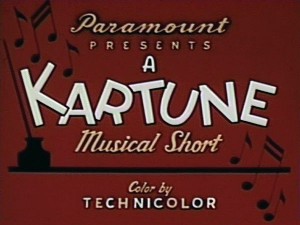 Fun at the Fair (Paramount/Famous, Kartune, 5/9/52 – I Sparber, dir.), receives a barely-honorable mention, nearly not qualifying for this survey. It is actually a slightly above-average “follow the bouncing ball” cartoon with a few clever gags. (One notable one has a bear encounter a barrel marked “Free Beer”. However, there is the catch that attached to the barrel is only a very tiny tin cup. The frustrated bear spies an exhibit of goldfish in bowls behind him. Grabbing up one of the bowls, he dispenses with the water with a quick toss, then fills the bowl to the brim with beer. However, he no sooner lifts the bowl to his lips, than the beer begins to rapidly vanish from within. A small toy sea castle remains within the bowl, and its occupant has not been jettisoned, as the goldfish sticks his head out after the last drop of beer has been drained dry, to emit an inebriated hiccup.) The film waits until the very last scenes to make the common mistake of crossing up fairs with circuses, highlighting a trapeze act between a mouse and a hippopotamus. Both are supposed to bite onto respective ends of a common small bar, suspending the hippo from both their teeth. Of course, using the same gag which had become an old wheeze by now, the hippo falls, thanks to wearing loose dentures.
Fun at the Fair (Paramount/Famous, Kartune, 5/9/52 – I Sparber, dir.), receives a barely-honorable mention, nearly not qualifying for this survey. It is actually a slightly above-average “follow the bouncing ball” cartoon with a few clever gags. (One notable one has a bear encounter a barrel marked “Free Beer”. However, there is the catch that attached to the barrel is only a very tiny tin cup. The frustrated bear spies an exhibit of goldfish in bowls behind him. Grabbing up one of the bowls, he dispenses with the water with a quick toss, then fills the bowl to the brim with beer. However, he no sooner lifts the bowl to his lips, than the beer begins to rapidly vanish from within. A small toy sea castle remains within the bowl, and its occupant has not been jettisoned, as the goldfish sticks his head out after the last drop of beer has been drained dry, to emit an inebriated hiccup.) The film waits until the very last scenes to make the common mistake of crossing up fairs with circuses, highlighting a trapeze act between a mouse and a hippopotamus. Both are supposed to bite onto respective ends of a common small bar, suspending the hippo from both their teeth. Of course, using the same gag which had become an old wheeze by now, the hippo falls, thanks to wearing loose dentures.
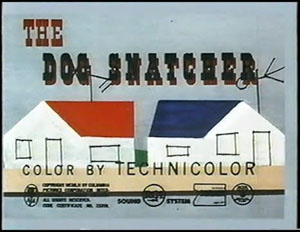 The Dog Snatcher (UPA/Columbia, Mister Magoo. 5/29/52 – Pete Burness, dir/) – Magoo is a dog owner, of a mutt named Cuddles. However, an observant dog catcher takes note that Cuddles has no license. “I walk the dog. I don’t drive him”, quips Magoo. Nevertheless, the determined officer declares that if Magoo doesn’t have a license by 12 noon, Cuddles goes to the pound. Magoo takes the dog catcher’s badge number (off from his own mailbox, reading the digits wrong to boot), then delivers a reassuring pat to a sawhorse instead of his dog, determined to get a license by the appointed time. However, as Magoo dons his coat, a circus parade enters town. Magoo spots a man-eating panther pacing back and forth in a circus wagon – and believes Cuddles has been incarcerated before the appointed time. Magoo vows to see the mayor about this, and turn city hall upside down. He attempts to hail a taxi, but winds up hitching a ride in the back of a clown’s car, which delivers him to the circus. The rear end of the vehicle explodes, and is replaced by a small descending staircase. Magoo complains about the “high running boards.” He questions a ticket taker as to the location of the mayor’s office, but is told, “How should I know? Beat it, rube.” Magoo raises a fuss at such impudence, catching his cane in the roll of tickets and unwinding it everywhere, as he insists he will not be caught up in red tape. Next, he wanders into the big top, interrupting a closed rehearsal.
The Dog Snatcher (UPA/Columbia, Mister Magoo. 5/29/52 – Pete Burness, dir/) – Magoo is a dog owner, of a mutt named Cuddles. However, an observant dog catcher takes note that Cuddles has no license. “I walk the dog. I don’t drive him”, quips Magoo. Nevertheless, the determined officer declares that if Magoo doesn’t have a license by 12 noon, Cuddles goes to the pound. Magoo takes the dog catcher’s badge number (off from his own mailbox, reading the digits wrong to boot), then delivers a reassuring pat to a sawhorse instead of his dog, determined to get a license by the appointed time. However, as Magoo dons his coat, a circus parade enters town. Magoo spots a man-eating panther pacing back and forth in a circus wagon – and believes Cuddles has been incarcerated before the appointed time. Magoo vows to see the mayor about this, and turn city hall upside down. He attempts to hail a taxi, but winds up hitching a ride in the back of a clown’s car, which delivers him to the circus. The rear end of the vehicle explodes, and is replaced by a small descending staircase. Magoo complains about the “high running boards.” He questions a ticket taker as to the location of the mayor’s office, but is told, “How should I know? Beat it, rube.” Magoo raises a fuss at such impudence, catching his cane in the roll of tickets and unwinding it everywhere, as he insists he will not be caught up in red tape. Next, he wanders into the big top, interrupting a closed rehearsal.
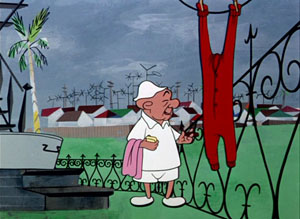 Bumping an acrobat off one end of a teeter-totter, Magoo is shot upwards in his place to a seat atop a tall balanced set of chairs. Magoo thinks he is in the mayor’s waiting room, and quietly relaxes despite the tipping back and forth of the chair pile, until he decides he’s waited long enough, and steps forward. He bounces a few times upon a tight wire, then lands on a rolling barrel, colliding with the entrance to a cage marked “Gorilla”. Thinking the word reads “Mayor” (an understandable mistake in most jurisdictions), Magoo enters the cage. He pleads his case for Cuddles’ release, but the ape, swinging back and forth within the cage, merely responds with chatter and grunts. Magoo thinks he is being given legal double-talk, and threatens to start a recall election. The swinging ape bumps into Magoo, knocking him out the cage door. “The old bum’s rush, eh?”, retorts Magoo. He looks up, and suddenly finds himself at the foot of the panther’s cage. Deciding to take the law into his own hands, Magoo enters the cage, and manages to snap a leash on the snarling panther. Magoo opens the cage door, and the panther takes the lead, tugging Magoo along wherever it pleases. A clown sounds an alarm to the crowd, which Magoo doesn’t hear. All he thinks when he sees the patrons exiting en masse is that they are typical civil servant clockwatchers dropping all work for their lunch break.
Bumping an acrobat off one end of a teeter-totter, Magoo is shot upwards in his place to a seat atop a tall balanced set of chairs. Magoo thinks he is in the mayor’s waiting room, and quietly relaxes despite the tipping back and forth of the chair pile, until he decides he’s waited long enough, and steps forward. He bounces a few times upon a tight wire, then lands on a rolling barrel, colliding with the entrance to a cage marked “Gorilla”. Thinking the word reads “Mayor” (an understandable mistake in most jurisdictions), Magoo enters the cage. He pleads his case for Cuddles’ release, but the ape, swinging back and forth within the cage, merely responds with chatter and grunts. Magoo thinks he is being given legal double-talk, and threatens to start a recall election. The swinging ape bumps into Magoo, knocking him out the cage door. “The old bum’s rush, eh?”, retorts Magoo. He looks up, and suddenly finds himself at the foot of the panther’s cage. Deciding to take the law into his own hands, Magoo enters the cage, and manages to snap a leash on the snarling panther. Magoo opens the cage door, and the panther takes the lead, tugging Magoo along wherever it pleases. A clown sounds an alarm to the crowd, which Magoo doesn’t hear. All he thinks when he sees the patrons exiting en masse is that they are typical civil servant clockwatchers dropping all work for their lunch break.
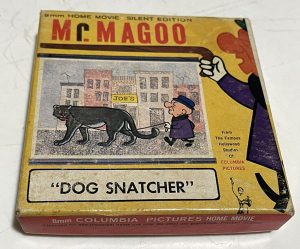 Magoo arrives home, tossing the evening paper into “Cuddles”’s mouth to bring inside. The panther chews the paper to shreds, which Magoo interprets as a sign that Cuddles must be hungry. Waiting behind the mailbox is the dog catcher, who cheats by setting his watch ten minutes forward so he can make his 12 noon catch. As Magoo enters the gate, the dog catcher slams down his net over what should be the dog – then responds to the realization of what is in his net, yelling “YAAAK!” “Yak? He’s a spaniel”, responds Magoo. Trying to steady the net upon the snarling beast, the dog catcher hands Magoo a license free of charge, it he’ll just call the creature off. Magoo responds with words of endearment to “Cuddles”, which have no effect on the panther, who breaks off the handle of the catcher’s net. The panther pursues the dog catcher up onto the porch of Magoo’s house, where he trips upon a large wash pail intended for Cuddles’ bath. The pail turns upside down, landing upon the panther, and the dog catcher does his best to keep the panther trapped within by sitting upon the pail. Two trainers from the circus arrive, and with some degree of difficulty manage to escort the panther away, with the dog catcher still riding atop him astride the pail. Magoo hollers from a window for the neighbor to “Shut off that dad-dratted radio. Sounds like a cat in a washtub”, as he stoops to place the license around the neck of a tiger-skin rug, while the real Cuddles looks on from across the room, shrugging his shoulders to the audience, as if this is just another typical day in the Magoo household.
Magoo arrives home, tossing the evening paper into “Cuddles”’s mouth to bring inside. The panther chews the paper to shreds, which Magoo interprets as a sign that Cuddles must be hungry. Waiting behind the mailbox is the dog catcher, who cheats by setting his watch ten minutes forward so he can make his 12 noon catch. As Magoo enters the gate, the dog catcher slams down his net over what should be the dog – then responds to the realization of what is in his net, yelling “YAAAK!” “Yak? He’s a spaniel”, responds Magoo. Trying to steady the net upon the snarling beast, the dog catcher hands Magoo a license free of charge, it he’ll just call the creature off. Magoo responds with words of endearment to “Cuddles”, which have no effect on the panther, who breaks off the handle of the catcher’s net. The panther pursues the dog catcher up onto the porch of Magoo’s house, where he trips upon a large wash pail intended for Cuddles’ bath. The pail turns upside down, landing upon the panther, and the dog catcher does his best to keep the panther trapped within by sitting upon the pail. Two trainers from the circus arrive, and with some degree of difficulty manage to escort the panther away, with the dog catcher still riding atop him astride the pail. Magoo hollers from a window for the neighbor to “Shut off that dad-dratted radio. Sounds like a cat in a washtub”, as he stoops to place the license around the neck of a tiger-skin rug, while the real Cuddles looks on from across the room, shrugging his shoulders to the audience, as if this is just another typical day in the Magoo household.
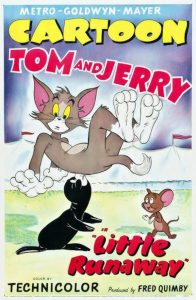 Little Runaway (MGM, Tom and Jerry, 6/14/52 – William Hanna/Joseph Barbera, dir.) – In the dead of night, a jail break takes place from a cage at a visiting circus. A small seal makes an escape in classic prisoner fashion – using a metal file on the cage bars. Morning light finds Jerry emerging from his exterior mousehole entrance in bathing trunks, planning a quick dip in the backyard pond. He dives in headfirst, but is stopped cold at the waterline by a solid obstacle – the submerged head of the seal. Though the seal talks only in barks, Jerry seems to have a perfect comprehension of his language, while we the audience are let in on the conversation by way of subtitles. The seal describes having run away, because he couldn’t take being made to play horn solos each day, which he demonstrates in pantomime, then adding “Ain’t it awful?” Jerry agrees to not give him away, then to help him get a fish. The closest source of supply is Tom’s dish. Jerry attempts to make off with Tom’s meal, but Tom opens his sleepy eyes. Jerry eclipses his own body behind the larger fish, and manipulates the fish’s fins so as to make the fish appear to come to life, fascinating the puzzled Tom by performing for him a “shuffle off to Buffalo” tap dance. Tom is inspired to applaud and provide whistling encouragement for an encore and repeated bows. After maneuvering the fish into taking two curtain calls, Jerry becomes the ham himself, losing track of the situation, and taking the third bow on his own. A furious Tom pursues, as Jerry races the fish out to the pond, tossing it into the water. The fish does not sink, again balanced at the waterline by the submerged seal, seeming to float while standing on its head. Tom plucks the fish out of the pond by its tail, then shakes it, only finding it to be very limp and deceased. As the perplexed Tom puzzles over the mystery, and as to the whereabouts of Jerry, the seal slips up out of the water, slurping up the fish from Tom’s hand behind his back. Jerry breaks up with laughter at Tom’s realization he’s lost his meal, but Tom quickly grabs up the mouse in one paw. Suddenly, Tom is raised two feet into the air, to find himself balanced on the little seal’s nose. The seal tosses Tom round in spirals like just another ball, then launches him into a backyard sundial, where the bowl of the device lands upon Tom’s head, temporarily making him look like an ancient Chinaman.
Little Runaway (MGM, Tom and Jerry, 6/14/52 – William Hanna/Joseph Barbera, dir.) – In the dead of night, a jail break takes place from a cage at a visiting circus. A small seal makes an escape in classic prisoner fashion – using a metal file on the cage bars. Morning light finds Jerry emerging from his exterior mousehole entrance in bathing trunks, planning a quick dip in the backyard pond. He dives in headfirst, but is stopped cold at the waterline by a solid obstacle – the submerged head of the seal. Though the seal talks only in barks, Jerry seems to have a perfect comprehension of his language, while we the audience are let in on the conversation by way of subtitles. The seal describes having run away, because he couldn’t take being made to play horn solos each day, which he demonstrates in pantomime, then adding “Ain’t it awful?” Jerry agrees to not give him away, then to help him get a fish. The closest source of supply is Tom’s dish. Jerry attempts to make off with Tom’s meal, but Tom opens his sleepy eyes. Jerry eclipses his own body behind the larger fish, and manipulates the fish’s fins so as to make the fish appear to come to life, fascinating the puzzled Tom by performing for him a “shuffle off to Buffalo” tap dance. Tom is inspired to applaud and provide whistling encouragement for an encore and repeated bows. After maneuvering the fish into taking two curtain calls, Jerry becomes the ham himself, losing track of the situation, and taking the third bow on his own. A furious Tom pursues, as Jerry races the fish out to the pond, tossing it into the water. The fish does not sink, again balanced at the waterline by the submerged seal, seeming to float while standing on its head. Tom plucks the fish out of the pond by its tail, then shakes it, only finding it to be very limp and deceased. As the perplexed Tom puzzles over the mystery, and as to the whereabouts of Jerry, the seal slips up out of the water, slurping up the fish from Tom’s hand behind his back. Jerry breaks up with laughter at Tom’s realization he’s lost his meal, but Tom quickly grabs up the mouse in one paw. Suddenly, Tom is raised two feet into the air, to find himself balanced on the little seal’s nose. The seal tosses Tom round in spirals like just another ball, then launches him into a backyard sundial, where the bowl of the device lands upon Tom’s head, temporarily making him look like an ancient Chinaman.
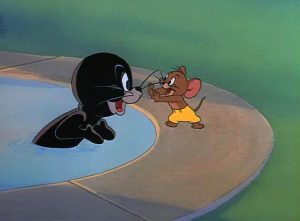 A radio bulletin is heard from the kitchen window, announcing a circus reward of $10,000 for the baby seal. Tom’s eyes widen, and his tongue emerges from his head in a greedy smile, as his vision transforms the seal’s image into that of a walking moneybag. As Tom grabs up the slippery seal, Jerry appears with a sack, seeming ready to help Tom in the capture. The seal is deposited in the sack, but Jerry casually makes off with the bag, leaving Tom with nothing but a shocked expression. Jerry rounds a corner outside the property wall, releases the seal, then tosses the empty sack over a fire hydrant. Tom, emerging from the front gate, makes a leap for the sack – but shatters like glass as he collides headfirst with the concealed hydrant. The seal skedaddles up a drainspout of the house, and Tom follows him to the roof. The chase now develops into a sort of mini-circus. The seal snaps off a power-line connection from the house to a pole, and swings to the top of a telephone pole as if performing a trapeze act. Tom grabs another wire and tries to repeat the swing – but smashes into the pole itself, knocking oit a center section of the pole and taking its place, as the pole’s weight crushes him to a height of about three inches. Of course, Tom’s recuperative powers have him whole again by the next shot, where Tom meets the seal on the power wires above. Armed with a kiddie bicycle and a balance pole, Tom pedals after the seal across the central of three power wires. The seal pauses to knot all three wires together at a central junction. As Tom’s bike passes over the knot, his vehicle neatly divides itself in three, each wheel following a different wire, and Tom left atop the pedaling gear, riding it like a unicycle. Reaching the next power pole, the seal makes a dive for the ground, and Jerry is waiting blow with a water glass, into and out of which the seal splashes with ease. Tom repeats the dive, but ends up compressed inside the glass in the same manner as Elmer Fudd in “Stage Door Cartoon”.
A radio bulletin is heard from the kitchen window, announcing a circus reward of $10,000 for the baby seal. Tom’s eyes widen, and his tongue emerges from his head in a greedy smile, as his vision transforms the seal’s image into that of a walking moneybag. As Tom grabs up the slippery seal, Jerry appears with a sack, seeming ready to help Tom in the capture. The seal is deposited in the sack, but Jerry casually makes off with the bag, leaving Tom with nothing but a shocked expression. Jerry rounds a corner outside the property wall, releases the seal, then tosses the empty sack over a fire hydrant. Tom, emerging from the front gate, makes a leap for the sack – but shatters like glass as he collides headfirst with the concealed hydrant. The seal skedaddles up a drainspout of the house, and Tom follows him to the roof. The chase now develops into a sort of mini-circus. The seal snaps off a power-line connection from the house to a pole, and swings to the top of a telephone pole as if performing a trapeze act. Tom grabs another wire and tries to repeat the swing – but smashes into the pole itself, knocking oit a center section of the pole and taking its place, as the pole’s weight crushes him to a height of about three inches. Of course, Tom’s recuperative powers have him whole again by the next shot, where Tom meets the seal on the power wires above. Armed with a kiddie bicycle and a balance pole, Tom pedals after the seal across the central of three power wires. The seal pauses to knot all three wires together at a central junction. As Tom’s bike passes over the knot, his vehicle neatly divides itself in three, each wheel following a different wire, and Tom left atop the pedaling gear, riding it like a unicycle. Reaching the next power pole, the seal makes a dive for the ground, and Jerry is waiting blow with a water glass, into and out of which the seal splashes with ease. Tom repeats the dive, but ends up compressed inside the glass in the same manner as Elmer Fudd in “Stage Door Cartoon”.
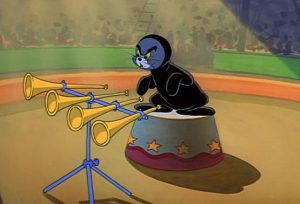 The final sequence finds Tom fashioning for himself a seal disguise, by slipping inside an old black rubber innertube. Tom appears between Jerry and the seal, balancing a ball on his nose, and heavily landing upon Jerry, whom Tom gets out of the way in a hurry by kicking a layer of dirt over him. Tom then lures the seal toward the front gate in a game of ball toss, reaching the gate first. As Tom waits for the seal to follow him out the gate, he receives an unexpected surprise, as a net is brought down upon him. The circus trainers have mistaken him for their prized attraction, and lock him in a wagon, transporting him back to the circus. There, for the evening performance, Tom is made to perform the seal’s horn act, begrudgingly reaching his last notes with off-the-beat hesitation. The crowd cheers, and Tom repeats Donald Duck’s closing gag from “Mickey’s Circus”, cheering for himself, only to get slapped in the mouth with a tossed fish.
The final sequence finds Tom fashioning for himself a seal disguise, by slipping inside an old black rubber innertube. Tom appears between Jerry and the seal, balancing a ball on his nose, and heavily landing upon Jerry, whom Tom gets out of the way in a hurry by kicking a layer of dirt over him. Tom then lures the seal toward the front gate in a game of ball toss, reaching the gate first. As Tom waits for the seal to follow him out the gate, he receives an unexpected surprise, as a net is brought down upon him. The circus trainers have mistaken him for their prized attraction, and lock him in a wagon, transporting him back to the circus. There, for the evening performance, Tom is made to perform the seal’s horn act, begrudgingly reaching his last notes with off-the-beat hesitation. The crowd cheers, and Tom repeats Donald Duck’s closing gag from “Mickey’s Circus”, cheering for himself, only to get slapped in the mouth with a tossed fish.
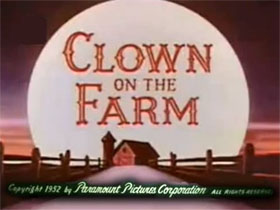 Clown on the Farm (Paramount/Famous, Noveltoon (Baby Huey), 8/10/52 – Seymour Kneitel, dir.) – A purely-formula Huey installment, with little new to offer. The ducklings are playing circus, balancing a bicycle upon a high wire. Huey wants to join the game, but bends the wire to the ground under his weight, then springs the ducklings off the wire into a well. The ducklings retaliate by having Huey dive through a hoop – with a barrel concealed behind it, to roll him helplessly down a steep hill. Enter the fox in search of a meal, whose imaginings at seeing the ducklings transform his lower jaw into a bowl full of duck soup. He pursues the ducklings with an axe, but Huey’s barrel rebounds off a tree limb, landing Huey atop the fox. The ducklings escape, but the fox views the oversize Huey as a side of beef marked ready for butcher cutting. A swing of the axe upon Huey’s head only splits the axe in two. Huey wails that no one will play circus with him, prompting the fox to adopt a ringmaster disguise. Huey asks to join up with the show, so the fox tries him out on a high diving act, with makeshift ladder built high above the clouds. As Huey falls from its dizzy heights, the fox pushes away the wooden walls of the water tank below, revealing a boiling stewpot. Huey plunges into, and through, the bottom of the pot, traveling through the ground in a U to pop up under the fox, rocketing him into the air. The fox collides with a passing plane, his head getting stuck int the plane’s rotary engine. Propelled by the engine, he saws through the trunks of seven trees, them leaves a crater in a wall of solid rock. Next, the fox tries Huey in a lion tamer act, posing in a lion costume to get Huey to put his head into the fox’s own mouth. Instead of getting dinner, the fox loses his dentures to Huey, who puts the bite with them on the fox instead. Finally, Huey is loaded into a cannon filled with dynamite. The blast fails to eject the overly-plump Huey, who plugs up the barrel, sending the force of the blast back upon the fox. Huey gets wise that the fox is trying to kill him, and ends the cartoon snapping the whip on the fox in a cage, who performs a handstand unicycle ride while juggling with his feet, as Huey becomes the favorite wild animal trainer of the ducklings, for the iris out.
Clown on the Farm (Paramount/Famous, Noveltoon (Baby Huey), 8/10/52 – Seymour Kneitel, dir.) – A purely-formula Huey installment, with little new to offer. The ducklings are playing circus, balancing a bicycle upon a high wire. Huey wants to join the game, but bends the wire to the ground under his weight, then springs the ducklings off the wire into a well. The ducklings retaliate by having Huey dive through a hoop – with a barrel concealed behind it, to roll him helplessly down a steep hill. Enter the fox in search of a meal, whose imaginings at seeing the ducklings transform his lower jaw into a bowl full of duck soup. He pursues the ducklings with an axe, but Huey’s barrel rebounds off a tree limb, landing Huey atop the fox. The ducklings escape, but the fox views the oversize Huey as a side of beef marked ready for butcher cutting. A swing of the axe upon Huey’s head only splits the axe in two. Huey wails that no one will play circus with him, prompting the fox to adopt a ringmaster disguise. Huey asks to join up with the show, so the fox tries him out on a high diving act, with makeshift ladder built high above the clouds. As Huey falls from its dizzy heights, the fox pushes away the wooden walls of the water tank below, revealing a boiling stewpot. Huey plunges into, and through, the bottom of the pot, traveling through the ground in a U to pop up under the fox, rocketing him into the air. The fox collides with a passing plane, his head getting stuck int the plane’s rotary engine. Propelled by the engine, he saws through the trunks of seven trees, them leaves a crater in a wall of solid rock. Next, the fox tries Huey in a lion tamer act, posing in a lion costume to get Huey to put his head into the fox’s own mouth. Instead of getting dinner, the fox loses his dentures to Huey, who puts the bite with them on the fox instead. Finally, Huey is loaded into a cannon filled with dynamite. The blast fails to eject the overly-plump Huey, who plugs up the barrel, sending the force of the blast back upon the fox. Huey gets wise that the fox is trying to kill him, and ends the cartoon snapping the whip on the fox in a cage, who performs a handstand unicycle ride while juggling with his feet, as Huey becomes the favorite wild animal trainer of the ducklings, for the iris out.
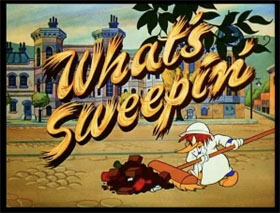 What’s Sweepin’ (Lantz/Universal, Woody Woodpecker, 1/5/53 – Don Patterson. dir.) – Set at the turn of the century, in the days of the horseless carriage, we find Woody Woodpecker employed as an old-fashioned street sweeper, with long broom and wheeled trash bucket. The job is a thankless one, and Woody receives no respect – especially from Wally Walrus, local cop on the beat, who tosses banana peels on Woody’s nose after consuming the fruit for free from a local grocer. And with a circus scheduled to come into town, all Woody can foresee is having to clean up after the elephants. Woody has had it, and decides to quit – but hits upon an idea for a life of ease, thanks to a second-hand officer’s uniform that has somehow made its way into the items he has collected in his trash can. Woody kicks his trash pail away, which rolls into Wally further down the street, carrying him down a hill and off a nearby pier into the harbor, where the sea water shrinks Wally’s outfit upon him, down to toddler size. Impersonating a policeman, Woody pulls the same stunt as Wally in mooching free fruit from the grocer – but overdoes it by cleaning out the fruit stand, and even stuffing an entire stalk of bananas inside his tall Keystone-Kop-type hat. He is caught red-handed by Wally, who smashes the bananas upon Woody’s head. Wally takes a swing at Woody with a night stick, but the woodpecker ducks, causing Wally to smash a store window instead. The shopkeeper emerges, mistaking Wally in his shrunken uniform for a delinquent child, and calling for assistance. Woody pulls a Bugs Bunny move, throwing on a second disguise in the form of a woman’s dress and wig from a tailor shop mannequin, and portraying “Junior”’s angry Mom, smacking Wally over the head with an umbrella – that is, until Woody’s skirt slips down, revealing his own short legs on stilts.
What’s Sweepin’ (Lantz/Universal, Woody Woodpecker, 1/5/53 – Don Patterson. dir.) – Set at the turn of the century, in the days of the horseless carriage, we find Woody Woodpecker employed as an old-fashioned street sweeper, with long broom and wheeled trash bucket. The job is a thankless one, and Woody receives no respect – especially from Wally Walrus, local cop on the beat, who tosses banana peels on Woody’s nose after consuming the fruit for free from a local grocer. And with a circus scheduled to come into town, all Woody can foresee is having to clean up after the elephants. Woody has had it, and decides to quit – but hits upon an idea for a life of ease, thanks to a second-hand officer’s uniform that has somehow made its way into the items he has collected in his trash can. Woody kicks his trash pail away, which rolls into Wally further down the street, carrying him down a hill and off a nearby pier into the harbor, where the sea water shrinks Wally’s outfit upon him, down to toddler size. Impersonating a policeman, Woody pulls the same stunt as Wally in mooching free fruit from the grocer – but overdoes it by cleaning out the fruit stand, and even stuffing an entire stalk of bananas inside his tall Keystone-Kop-type hat. He is caught red-handed by Wally, who smashes the bananas upon Woody’s head. Wally takes a swing at Woody with a night stick, but the woodpecker ducks, causing Wally to smash a store window instead. The shopkeeper emerges, mistaking Wally in his shrunken uniform for a delinquent child, and calling for assistance. Woody pulls a Bugs Bunny move, throwing on a second disguise in the form of a woman’s dress and wig from a tailor shop mannequin, and portraying “Junior”’s angry Mom, smacking Wally over the head with an umbrella – that is, until Woody’s skirt slips down, revealing his own short legs on stilts.
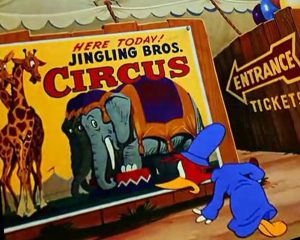 The pursuit begins, and Woody, still in his cop costume, ducks into the circus grounds. Wally still can’t convince anyone he’s a real policeman to gain entry to the show, due to his shrunken outfit. “Run along home, before I call a cop”, says the ticket taker. “Beat it, Junior, and take off that trick moustache”, yells a roustabout. With a carpet over his back, and a long stocking hanging from his nose, Wally finally has to resort to parading himself in between the circus elephants in order to enter the big top. But Woody is riding the elephant right behind him, and has the elephant toss Wally high into the air with his trunk. Wally lands on a platform that seems to be decked out with all the makings of a comfortable living room – padded easy chair, end table, throw rug, TV set, and even a fresh glass of lemonade. Then, things get even more surreal, as a shapely young woman sails slowly by overhead, as if something out of a dream. As the girl passes once more, Wally cannot resist his instincts to reach out and grab hold of her. Unfortunately, she is a passing trapeze performer, and Wally steps off the platform into thin air. He barely saves himself by grabbing hold of the end strands of the rug, and looks down to see the platform is mounted atop a 200-foot tall pole, balanced upon the tongue of a strong man. Below, Woofy makes things more difficult for Wally, giving the strong man a hotfoot, then pecking his way up the center of the pole to disintegrate it. Woody pecks Wally In the rear end, then tosses him into the middle of a trapeze act. As Wally swings back toward Woody, Woody holds oy a bar for Wally to grab – the center bar of a massive barbell. Wally lands with it atop a tight wire where a group of acrobats has achieved a four-man pyramid with bicycle atop the wire.
The pursuit begins, and Woody, still in his cop costume, ducks into the circus grounds. Wally still can’t convince anyone he’s a real policeman to gain entry to the show, due to his shrunken outfit. “Run along home, before I call a cop”, says the ticket taker. “Beat it, Junior, and take off that trick moustache”, yells a roustabout. With a carpet over his back, and a long stocking hanging from his nose, Wally finally has to resort to parading himself in between the circus elephants in order to enter the big top. But Woody is riding the elephant right behind him, and has the elephant toss Wally high into the air with his trunk. Wally lands on a platform that seems to be decked out with all the makings of a comfortable living room – padded easy chair, end table, throw rug, TV set, and even a fresh glass of lemonade. Then, things get even more surreal, as a shapely young woman sails slowly by overhead, as if something out of a dream. As the girl passes once more, Wally cannot resist his instincts to reach out and grab hold of her. Unfortunately, she is a passing trapeze performer, and Wally steps off the platform into thin air. He barely saves himself by grabbing hold of the end strands of the rug, and looks down to see the platform is mounted atop a 200-foot tall pole, balanced upon the tongue of a strong man. Below, Woofy makes things more difficult for Wally, giving the strong man a hotfoot, then pecking his way up the center of the pole to disintegrate it. Woody pecks Wally In the rear end, then tosses him into the middle of a trapeze act. As Wally swings back toward Woody, Woody holds oy a bar for Wally to grab – the center bar of a massive barbell. Wally lands with it atop a tight wire where a group of acrobats has achieved a four-man pyramid with bicycle atop the wire.
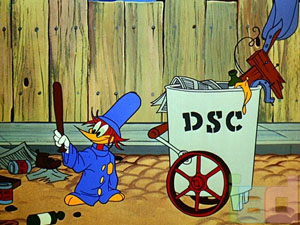 Wally’s impact somehow inverts the pyramid, placing Wally balanced on hs head at the bottom, with one of the acrobats at the top spinning the barbell with his feet. At one end of the wire, Woody ignites a campfire, sending a red-hot wave of heat pulsing through the wire. Wally blows at it in attempt to keep things cool, but is ultimately forced to run while upside down, propelled only by walking upon the strands of his moustache. Woody will give no quarter nor take any prisoners, now waiting at the other end of the wire with a large pair of gardening shears, to snip the wire out from under Wally. Wally falls toward a large net far below. Woody attempts to booby-trap the net by placing the tines of a pitchfork facing upwards directly under it. Wally misses the pitchfork, hitting the opposite side of the net, and bouncing back into the air. Woody repositions the pitchfork, but Wally misses again, bouncing off the side of the net where Woody had first expected him. To cover all bases, Woody erects about twenty putchforks at every position under the net. YEOWWWCH!!!! Wally jumps back up to trapeze level again, but as he reaches for a trapeze bar, Woody is again one step ahead of hip, slipping the bar sideways out of its moorings to keep it out of reach. Wally falls into a cannon, and Woody lights the fuse. The blast causes Wally to rip the entire tent from its rope moorings, the canvas falling with a plop flat upon the ground. But from among the folds rises Wally, at last holding Woody’s neck in a stranglehold. Wally replicates Woody’s laugh as closely as possible in his basso voice, and the final shot shows the circus elephants leaving town, with Woody back to his old post of street cleaner to clean up after them, with one change – he is now manacled to his mobile trash can by a metal collar and chain, ensuring his tenure will be permanent. Woody grumbles visibly, for the fade out.
Wally’s impact somehow inverts the pyramid, placing Wally balanced on hs head at the bottom, with one of the acrobats at the top spinning the barbell with his feet. At one end of the wire, Woody ignites a campfire, sending a red-hot wave of heat pulsing through the wire. Wally blows at it in attempt to keep things cool, but is ultimately forced to run while upside down, propelled only by walking upon the strands of his moustache. Woody will give no quarter nor take any prisoners, now waiting at the other end of the wire with a large pair of gardening shears, to snip the wire out from under Wally. Wally falls toward a large net far below. Woody attempts to booby-trap the net by placing the tines of a pitchfork facing upwards directly under it. Wally misses the pitchfork, hitting the opposite side of the net, and bouncing back into the air. Woody repositions the pitchfork, but Wally misses again, bouncing off the side of the net where Woody had first expected him. To cover all bases, Woody erects about twenty putchforks at every position under the net. YEOWWWCH!!!! Wally jumps back up to trapeze level again, but as he reaches for a trapeze bar, Woody is again one step ahead of hip, slipping the bar sideways out of its moorings to keep it out of reach. Wally falls into a cannon, and Woody lights the fuse. The blast causes Wally to rip the entire tent from its rope moorings, the canvas falling with a plop flat upon the ground. But from among the folds rises Wally, at last holding Woody’s neck in a stranglehold. Wally replicates Woody’s laugh as closely as possible in his basso voice, and the final shot shows the circus elephants leaving town, with Woody back to his old post of street cleaner to clean up after them, with one change – he is now manacled to his mobile trash can by a metal collar and chain, ensuring his tenure will be permanent. Woody grumbles visibly, for the fade out.
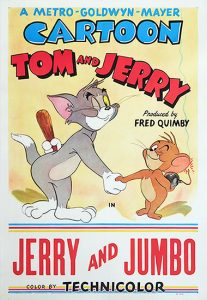 Jerry and Jumbo (MGM, Tom and Jerry, 2/21/53 – William Hanna/Joseph Barbera, dir.) – As previously noted, here Hanna and Barbera perform an unusual lift of an idea from Terrytoons – which was itself a lift of an idea from Warner Brothers – yet manage to make the borrowed premise uniquely memorable and entertaining. Following the pattern of both the Sylvester and Hippity Hopper series, and also the more closely-akin Terrytoon “The Elephant Mouse”, previously reviewed, the film opens as a circus train passes through the night, one of its box cars left with a side panel wide open. Inside, a mother and baby elephant snooze lazily – but the vibration of the train causes the baby elephant to fall out the side, rolling like a ball down a hill, and into the living room of Tom and Jerry’s home. Little Jumbo winds up inside Tom’s bed basket, and hides under the blanket as Tom appears to settle down for a snooze. Tom pushes upon the blanket to adjust the bedding, and thinks he’s seeing things when his pushing pops out the momentary glimpse of a trunk. As Tom closes his eyes, the elephant steps out of the basket with Tom astride, and makes a run for it, smashing Tom headfirst into a table above. The puzzled cat, seeing no sign of the elephant, can’t figure out how his blanket transported him here, and trudges back to his basket to resume his rest. The hungry elephant, peering from around a corner, spots something tempting in Tom’s bowl – milk. With a vacuum suction from his trunk, the elephant cleanly sucks away the entire contents of the milk bowl, startling Tom awake once again. Having only seen the direction in which the milk disappeared, Tom proceeds with the empty bowl in an angry stalk to the kitchen to find the culprit, passing entirely the elephant concealed behind an easy chair. In the kitchen, Jerry just happens to be on a late evening raid of the refrigerator, sucking up his own dose of milk from a bottle with a straw. Jerry slams the refrigerator door shut as he hears Tom’s approach, but is unable to convince Tom of his innocence, as Tom catches sight of a drop of milk trickling from one of Jerry’s whiskers. Tom raises the bowl to smash down upon Jerry, but the watchful elephant saves Jerry’s neck by a powerful vacuum suck with his trunk, pulling Jerry out of the way as the bowl is smashed by Tom upon the now-empty kitchen counter. Tom leaves with no idea where Jerry disappeared, while the elephant and mouse become fast friends.
Jerry and Jumbo (MGM, Tom and Jerry, 2/21/53 – William Hanna/Joseph Barbera, dir.) – As previously noted, here Hanna and Barbera perform an unusual lift of an idea from Terrytoons – which was itself a lift of an idea from Warner Brothers – yet manage to make the borrowed premise uniquely memorable and entertaining. Following the pattern of both the Sylvester and Hippity Hopper series, and also the more closely-akin Terrytoon “The Elephant Mouse”, previously reviewed, the film opens as a circus train passes through the night, one of its box cars left with a side panel wide open. Inside, a mother and baby elephant snooze lazily – but the vibration of the train causes the baby elephant to fall out the side, rolling like a ball down a hill, and into the living room of Tom and Jerry’s home. Little Jumbo winds up inside Tom’s bed basket, and hides under the blanket as Tom appears to settle down for a snooze. Tom pushes upon the blanket to adjust the bedding, and thinks he’s seeing things when his pushing pops out the momentary glimpse of a trunk. As Tom closes his eyes, the elephant steps out of the basket with Tom astride, and makes a run for it, smashing Tom headfirst into a table above. The puzzled cat, seeing no sign of the elephant, can’t figure out how his blanket transported him here, and trudges back to his basket to resume his rest. The hungry elephant, peering from around a corner, spots something tempting in Tom’s bowl – milk. With a vacuum suction from his trunk, the elephant cleanly sucks away the entire contents of the milk bowl, startling Tom awake once again. Having only seen the direction in which the milk disappeared, Tom proceeds with the empty bowl in an angry stalk to the kitchen to find the culprit, passing entirely the elephant concealed behind an easy chair. In the kitchen, Jerry just happens to be on a late evening raid of the refrigerator, sucking up his own dose of milk from a bottle with a straw. Jerry slams the refrigerator door shut as he hears Tom’s approach, but is unable to convince Tom of his innocence, as Tom catches sight of a drop of milk trickling from one of Jerry’s whiskers. Tom raises the bowl to smash down upon Jerry, but the watchful elephant saves Jerry’s neck by a powerful vacuum suck with his trunk, pulling Jerry out of the way as the bowl is smashed by Tom upon the now-empty kitchen counter. Tom leaves with no idea where Jerry disappeared, while the elephant and mouse become fast friends.
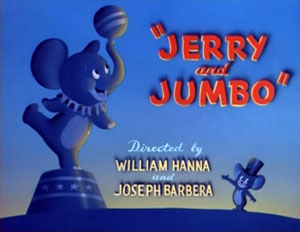 Now Jerry attempts to return the favor, helping the elephant obtain a bag of peanuts from a high pantry shelf. The theft is bungled, as the bag breaks over Jumbo’s head, scattering peanuts everywhere. Tom, hearing the clatter, races again to the kitchen, while Jerry and the elephant make a hasty retreat to a hall closet. But the elephant can’t resist a free meal, and sticks his trunk out under the door, performing another vacuum suck that neatly lines up and parades all the peanuts across the kitchen and under the door, right before Tom’s eyes. Tom is now sure of mischief afoot, and pounds on the closet door for entry. Jerry and Jumbo cower inside the closet, praying the lock will hold – then, Jerry gets a brilliant idea. Spotting a paintbrush and cans of black and brown paint, Jerry whispers his idea to the elephant. The elephant neatly rolls up his trunk into a round ball, and Jerry paints it black, matching his own nose. With the brown paint, he entirely paints the elephant’s body – until Jumbo looks like a scale-model enlargement of Jerry himself. When things are ready, the two unlock the closet from the inside. Tom yanks open the door, to find Jerry in plain view, waiting for him with a hammer. BAM goes the hammer on Tom’s big toe, as Jerry pulls the closet door shut. Tom yanks it open again, looking down for his expected adversary – but instead, encounters the painted Jumbo, holding the hammer high above Tom to conk him on the head. The door is pulled closed again, and Tom hesitates, not sure whether to believe what he last saw. With stealth, he opens the door again, for a peek that lasts well under a second. The giant mouse is still there – sending Tom into near shock! Slowly retrieving a baseball bat for protection, Tom opens the door again. But now, it’s back to little Jerry, for another hammer whack on Tom’s toe. Tom is ready to rip the door off its hinges in anger, when he finds himself nose to nose with the giant again. Jumbo pulls a “Sunfay punch” surprise, extending his coiled-up trunk like a fighting fist, smashing Tom in the face, and sending him flying backwards, through the wooden cabinetry of an old Hutch.
Now Jerry attempts to return the favor, helping the elephant obtain a bag of peanuts from a high pantry shelf. The theft is bungled, as the bag breaks over Jumbo’s head, scattering peanuts everywhere. Tom, hearing the clatter, races again to the kitchen, while Jerry and the elephant make a hasty retreat to a hall closet. But the elephant can’t resist a free meal, and sticks his trunk out under the door, performing another vacuum suck that neatly lines up and parades all the peanuts across the kitchen and under the door, right before Tom’s eyes. Tom is now sure of mischief afoot, and pounds on the closet door for entry. Jerry and Jumbo cower inside the closet, praying the lock will hold – then, Jerry gets a brilliant idea. Spotting a paintbrush and cans of black and brown paint, Jerry whispers his idea to the elephant. The elephant neatly rolls up his trunk into a round ball, and Jerry paints it black, matching his own nose. With the brown paint, he entirely paints the elephant’s body – until Jumbo looks like a scale-model enlargement of Jerry himself. When things are ready, the two unlock the closet from the inside. Tom yanks open the door, to find Jerry in plain view, waiting for him with a hammer. BAM goes the hammer on Tom’s big toe, as Jerry pulls the closet door shut. Tom yanks it open again, looking down for his expected adversary – but instead, encounters the painted Jumbo, holding the hammer high above Tom to conk him on the head. The door is pulled closed again, and Tom hesitates, not sure whether to believe what he last saw. With stealth, he opens the door again, for a peek that lasts well under a second. The giant mouse is still there – sending Tom into near shock! Slowly retrieving a baseball bat for protection, Tom opens the door again. But now, it’s back to little Jerry, for another hammer whack on Tom’s toe. Tom is ready to rip the door off its hinges in anger, when he finds himself nose to nose with the giant again. Jumbo pulls a “Sunfay punch” surprise, extending his coiled-up trunk like a fighting fist, smashing Tom in the face, and sending him flying backwards, through the wooden cabinetry of an old Hutch.
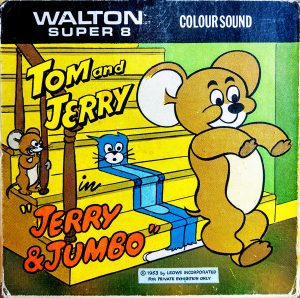 Tom eventually returns to the closet, trembling – only to find it empty. A sound from the next room sends him in pursuit of the strange size-shifting mouse, leading to a sequence somewhat resembling the mirror routine from the Marx Brothers’ “Duck Soup”. Tom passes a hallway opening leading to the living room. As he runs past, the image of the giant mouse mimics his every step on the other side of the entryway. Tom passes in reverse direction, and it is now little Jerry doing the mimicking. Tom thinks he is getting the hang of whether the big or the little image will follow him, until both images follow at once, leaving Tom with an expression that can only be described as “freaked out”. Tom runs through the entrance and round a corner, to spot the shocking sight of a pair of twin mouseholes in the wall – one five times the size of Jerry’s little one. Tom attempts to counter this development by producing a mousetrap five times normal size, but the elephant turns on the vacuum pill from the hole, sucking Tom’s rear end right into his own trap. Tom spies Jerry dart into a normal mousehole on the opposite wall. Tom reaches his paw inside to grab him. On the other side of the wall, within an adjoining room, Jerry is joined by the elephant. Jumbo turns his tail toward Tom’s grasping hand, volunteering to get “caught”. Tom grabs hold, but can’t tug the huge monster on the other side through the small hole – that is, until he pills so hard, Jumbo bursts right through the wall, landing in Tom’s arms and knocking him off-balance backwards into a staircase. Jumbo lands with crushing weight upon Tom at the base of the stairs, flattening him into a series of right-angle folds tracing the outline of the first four or five stairs.
Tom eventually returns to the closet, trembling – only to find it empty. A sound from the next room sends him in pursuit of the strange size-shifting mouse, leading to a sequence somewhat resembling the mirror routine from the Marx Brothers’ “Duck Soup”. Tom passes a hallway opening leading to the living room. As he runs past, the image of the giant mouse mimics his every step on the other side of the entryway. Tom passes in reverse direction, and it is now little Jerry doing the mimicking. Tom thinks he is getting the hang of whether the big or the little image will follow him, until both images follow at once, leaving Tom with an expression that can only be described as “freaked out”. Tom runs through the entrance and round a corner, to spot the shocking sight of a pair of twin mouseholes in the wall – one five times the size of Jerry’s little one. Tom attempts to counter this development by producing a mousetrap five times normal size, but the elephant turns on the vacuum pill from the hole, sucking Tom’s rear end right into his own trap. Tom spies Jerry dart into a normal mousehole on the opposite wall. Tom reaches his paw inside to grab him. On the other side of the wall, within an adjoining room, Jerry is joined by the elephant. Jumbo turns his tail toward Tom’s grasping hand, volunteering to get “caught”. Tom grabs hold, but can’t tug the huge monster on the other side through the small hole – that is, until he pills so hard, Jumbo bursts right through the wall, landing in Tom’s arms and knocking him off-balance backwards into a staircase. Jumbo lands with crushing weight upon Tom at the base of the stairs, flattening him into a series of right-angle folds tracing the outline of the first four or five stairs.
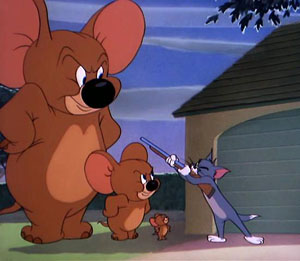 Tom is about to crack, and sees no alternative to this situation but to break out the heavy artillery. With a hunting rifle, he begins to pursue Jerry around the living room. The elephant ducks out of sight behind a chair as he passes – then sees a friendly sight at an open window. Mama elephant has caught up with him from the train, and tenderly hugs her baby with her trunk at the window. More blasts from Tom’s shotgun are heard, causing Mama to lift Jumbo out the window and out of harm’s way, as Tom and Jerry pass again. Jerry runs out the front door into the night, where he hears a whistle to himself from behind the garage. It is Jumbo beckoning to him – and holding the paintbrush seen previously. Jerry ducks with Jumbo around the side of the garage, as Tom emerges from the front door, still ready to blast all opponents. As Tom pauses near the garage, Jerry hops out into plain view from around the corner. Tom levels his weapon at Jerry, but then Jumbo leaps out, right behind the mouse. Tom raises his rifle to draw a bead on the bigger rodent. Then – surprise! – the full-grown Mama jumps out right behind Jumbo. She too is now painted to look like an even bigger carbon-copy of Jerry. This unbelievable sight freezes Tom dead in his tracks, as the barrel of his shotgun droops like a limp fish. Tom turns to the audience, his face assuming a demented, twisted smile of insanity, as he gestures sizes with one hand, as if to say, “Little. Medium. Big?????” Breaking into hysterical, uncontrollable laughter, Tom exits the film in a line for the horizon, smashing through fences and walls along the way as if they were made of crackers, for the iris out.
Tom is about to crack, and sees no alternative to this situation but to break out the heavy artillery. With a hunting rifle, he begins to pursue Jerry around the living room. The elephant ducks out of sight behind a chair as he passes – then sees a friendly sight at an open window. Mama elephant has caught up with him from the train, and tenderly hugs her baby with her trunk at the window. More blasts from Tom’s shotgun are heard, causing Mama to lift Jumbo out the window and out of harm’s way, as Tom and Jerry pass again. Jerry runs out the front door into the night, where he hears a whistle to himself from behind the garage. It is Jumbo beckoning to him – and holding the paintbrush seen previously. Jerry ducks with Jumbo around the side of the garage, as Tom emerges from the front door, still ready to blast all opponents. As Tom pauses near the garage, Jerry hops out into plain view from around the corner. Tom levels his weapon at Jerry, but then Jumbo leaps out, right behind the mouse. Tom raises his rifle to draw a bead on the bigger rodent. Then – surprise! – the full-grown Mama jumps out right behind Jumbo. She too is now painted to look like an even bigger carbon-copy of Jerry. This unbelievable sight freezes Tom dead in his tracks, as the barrel of his shotgun droops like a limp fish. Tom turns to the audience, his face assuming a demented, twisted smile of insanity, as he gestures sizes with one hand, as if to say, “Little. Medium. Big?????” Breaking into hysterical, uncontrollable laughter, Tom exits the film in a line for the horizon, smashing through fences and walls along the way as if they were made of crackers, for the iris out.
NEXT WEEK: The parade of 50’s attractions continues.


 Charles Gardner is an animation enthusiast who toils by day as a member of LA Law – but by nights and weekends indulges in classic jazz and ragtime as a performer; and studies classic Hollywood cartoons… maybe a little too much.
Charles Gardner is an animation enthusiast who toils by day as a member of LA Law – but by nights and weekends indulges in classic jazz and ragtime as a performer; and studies classic Hollywood cartoons… maybe a little too much.


































































































































































A lot of very fine, very funny cartoons this week, except for the Famous ones. “Jerry and Jumbo” is a particular favourite: I remember watching it as a little boy and laughing so hard, I could scarcely breathe. It still cracks me up today. But whoever drew that illustration for the Walton Super 8 box makes Bela Rieger look like Preston Blair.
Even the UPA cartoon, for once, is full of laughs. The biggest one is at the very end, when Magoo says “We can’t stand this modern music!” just as Bill Lava’s score reaches its addlepated climax.
Bruno the Slobokian bear is one of McKimson’s one-off characters — like Pete Puma, Professor Calvin Q. Calculus, and the Wild Wife — that I wish had been brought back for additional cartoons. He wouldn’t necessarily have to be a circus bear; he could just be a wild bear in the woods, doing whatever it is that bears do in the woods until Bugs or Daffy comes along to throw a wrench into his plans. Given his evident origin behind the Iron Curtain, Bruno could even have been the subject of some pointed Cold War satire, though something tells me Eddie Selzer would have put the kibosh on that.
Funny how Wally Walrus’s Swedish accent gets all Irish as soon as he puts on a policeman’s uniform.
In “Fun at the Fair”, there’s a vendor selling “Jelly Apples”. I’ve heard of apple jelly, but I’ve never heard of jelly apples. Are they the same as the caramel apples that kids break their teeth on at Halloween? Or are jelly apples a specifically New York City thing, like egg creams and knishes?
Based on his track record I think Selzer would have tried until the guys would make the cartoon anyway. Be another opportunity to accept an Oscar while thanking the animators that ignored him.
You’ve covered David Hand’s Animaland cartoons in these articles before, so I’m a little surprised that you’ve overlooked “Ginger Nutt’s Christmas Circus” (Gaumont British Animation, 1949 — Bert Felstead, dir.). The eighth and penultimate entry in the series, it unites all of the Animaland characters in a circus setting.
The woodland animals are converging on a snow-covered evergreen tree for the Christmas circus, where a sign outside the box office conspicuously warns: “No gate-crashers”. An obnoxious parrot tries to enter without a ticket and is thrown out into the snow. When he sees a weasel approaching with ticket in hand, the parrot pretends to be the ticket-taker, takes the weasel’s ticket and uses it to gain admission, while the now ticketless weasel is denied entry. The weasel’s subsequent attempts to get into the circus form a running gag, such as it is, for much of the cartoon.
The Christmas Circus features a variety of acts, including: a circus parade; two kookaburras riding unicycles and doing tricks with a magic hat; a cat balancing on the high wire; an ostrich putting his head in a lion’s mouth; and a pair of juggling platypus. The parrot heckles the performers throughout, accusing them of being “fake,” as Little Lulu did in “Hullaba-Lulu”.
Finally the weasel manages to get in and chases the parrot into the centre ring. The chase culminates inside a cannon, which blasts the two of them far into the distance. Landing in the snow, the weasel grabs the parrot and is ready to clobber him, when a mole in a Father Christmas costume emerges from the snow with a sign bearing the yuletide message of “Peace on Earth”. The weasel has an apparent change of heart and shakes hands with the parrot. Then he grabs the sign and hits the parrot over the head with it.
Thanks for the catch (saving me a review). I don’t have a filmography on the Animaland shorts, so didn’t remember where this film fit in chronologically. “Christmas Circus”, by the way, is one of my favorite of these shorts, being decidedly more “toony” in gag content and faster-paced than most other entries.
Say what you will about the early Fifties Lantz cartoons, but IMO Woody never had a more appealing and attractive design before or since. This era is in between the Daffy Duck bill and when he he became flat and gnat-sized.
Most animation books complain about the sameness of the Casper cartoons, quoting Lee Mishkin’s “You never knew which one you were working on,” although interestingly no one’s ever leveled that same charge against the even more indistinguishable (if arguably cleverer and better animated) Roadrunner cartoons. At least the Caspers, bland and unimaginative as they could be, had a more noble theme, the outsider’s pursuit of acceptance; whereas the RRs were merely about self-defeat.
Repetition in 20s, 30s, 40s and early 50s theatrical cartoons had an excuse. They were never meant to be seen beyond the year they were released. There were no reissues, no TV sales, no cable, streaming, home video or VHS/DVD/blu-rays. If a cartoon got a big laugh or simply a good reaction, the studio could remake the cartoon, or reuse the premise – and audiences then were delighted to see that cartoon again (or for the first time) a year or two later. No one complained. That’s why they only needed one, two or three plot lines for Baby Huey, Casper, Pepe LePew, Foghorn Leghorn, Mighty Mouse, etc. It’s only since the flood of older cartoons to television, shown in large cartoon blocks or compiled into un-curated programming that runs them back-to-back, since the mid-1950s, that we notice the repetition. The miracle is how many cartoons don’t repeat the same scenarios over and over again – The Tom & Jerry’s, The Tex Avery’s, most Jones-Freleng-Clampett, most Disney shorts… That – plus the artistic quality of the old theatricals is so high – we forgive the repetition. And heck, sometimes the remakes are better than the originals.
Not just cartoons. B movie series would recycle footage and plot lines, and serials and westerns would salvage action scenes. If you take on the “Francis the Talking Mule” movies, you’ll note how the same plot line and even the same gags play out as insistently as a Casper cartoon. Meanwhile, nearly all the “Mexican Spitfire” films found an excuse for the heroine’s uncle (Leon Errol) to impersonate a drunken English lord (also Errol).
Even the MGM Tarzan movies would not only recycle shots (the same crocodile slides into the river in nearly every film), but occasionally whole sequences, particularly Tarzan’s battle with a rhino.
Speaking of Famous, correct me if I’m wrong, but weren’t the cartoons directly differently than the cartoons at the West Coast studios? This might explain the somewhat sameness of some of the series.
Yeah they were directed differently. Sparber and keitel were supervisors. They supervised the recording sessions and story sessions with final approval on all story’s. Once scripts were done they were given to the head animators of the units(Al eugster, Dave Tendlar, tom Johnson, Myron Walkman, Steve muffati) these unit supervisors did much of the actual directing work on the cartoons such as layouts. Essentially it would be like if Fred quimby headed the story departments and Tex Avery and Hanna and barbera at mgm merely supervised animation and didn’t have the level of creative freedom. That’s what it basically was
Oh and I forgot to mention that this was a continuation of the fleischer system and which was only dropped by shamus Culhane in the 60s
As we get into the 50s, note the television shows using a circus setting for opening titles: Barker Bill, Huckleberry Hound, Funday Funnies, Even the original Mickey Mouse Club titles has a circus vibe.
Plus, “The Mickey Mouse Club” had “Circus Day” every Thursday during the first season or so. It also inspired the short-lived “Mickey Mouse Club Circus” at Disneyland (which Walt quickly learned that circuses do not mix with the theme park business).
Personally, I think Bruno in ‘Big Top Bunny’ is one of the handsomest bears ever seen in a cartoon.